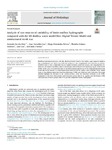Analysis of two sources of variability of basin outflow hydrographs computed with the 2D shallow water model Iber: Digital Terrain Model and unstructured mesh size

Use this link to cite
http://hdl.handle.net/2183/31405
Except where otherwise noted, this item's license is described as Atribución-NoComercial-SinDerivadas 3.0 España
Collections
- Investigación (ETSECCP) [826]
Metadata
Show full item recordTitle
Analysis of two sources of variability of basin outflow hydrographs computed with the 2D shallow water model Iber: Digital Terrain Model and unstructured mesh sizeAuthor(s)
Date
2022Citation
García-Alén, G., González-Cao, J., Fernández-Nóvoa, D., Gómez-Gesteira, M., Cea, L., Puertas, J. (2022). Analysis of two sources of variability of basin outflow hydrographs computed with the 2d shallow water model iber: digital terrain model and unstructured mesh size. Journal of Hydrology, 612, 128182.
Abstract
[Abstract:] Modelling hydrological processes with fully distributed models based on the shallow water equations implies a high computational cost, which often limits the resolution of the computational mesh. Therefore, in practice, modellers need to find a compromise between spatial resolution, numerical accuracy and computational cost. Moreover, this balance is probably related to the accuracy and resolution of the underlying Digital Terrain Model (DTM). In this work, it is studied the effect of the DTM resolution and the size of the computational mesh on the results and on the runtime of a hydrological model based on the 2D shallow water equations. Seven rainfall events in four different basins have been modelled using 3 DTMs and 3 different mesh resolutions. The results obtained highlight the relevance of the vertical accuracy versus the horizontal resolution of the DTMs. Furthermore, it has been observed that mesh resolutions greater than 25 m, together with LiDAR-based DTMs with horizontal resolution greater than 25 m, provide comparable outflow hydrographs.
Keywords
SRTMIGN
Digital elevation model
Iber
Mesh size
Runoff
Digital elevation model
Iber
Mesh size
Runoff
Description
Financiado para publicación en acceso aberto: Universidade da Coruña/CISUG
Editor version
Rights
Atribución-NoComercial-SinDerivadas 3.0 España






